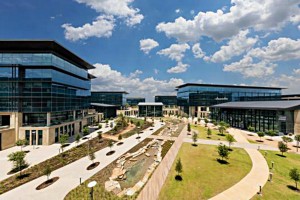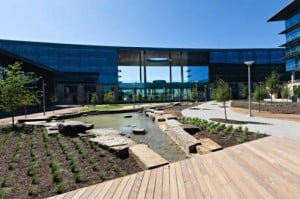State Of The Arts: Architecture Takes On The North Texas Landscape
ArtandSeek.net November 10, 2017 34We North Texans continue to fill our landscape with construction projects – like Toyota’s new headquarters in Plano. Architecture critic Mark Lamster says we need to consider what such developments mean to transit systems and to the environment.
In our weekly State of the Arts conversation, Art&Seek’s Jerome Weeks talks with Lamster about architecture meeting the countryside.
Here’s the extended conversation:
Mark, recently you wrote an extensive consideration of the new Toyota headquarters built in Plano. Could you summarize your response to that new complex?
Well, I called it the Camry of architecture. Which is to say conservative. Not especially exciting, but safe, efficient and functional. It makes great efforts at sustainability and about being green. But it’s also in the corporate suburbia of Plano. And that’s an important choice.
So the question for me is, ‘how environmentally sustainable can we actually call a big corporate office of an automaker that isn’t connected to the Dallas transit system?’
The suburban corporate campus has become a signature modern structure. It grew out of industrial complexes – like the Ford River Rouge Plant, designed by Albert Kahn. But when the suburbs came along, corporate headquarters moved out there as well – with such pioneering efforts as Bell Laboratories in New Jersey and the GM Tech Center outside Detroit, both designed by Eero Saarinen. But that means corporate headquarters are no longer located in downtown office buildings or factories. They’re now ‘campuses.’ They blend buildings with the landscape. Architect and scholar Louise Mozingo has termed all this ‘pastoral capitalism.
But to play devil’s advocate here: Your piece seemed to object to the very nature of the suburban corporate campus.
I think the real issue is that we need to understand that that’s what’s happening. And that this move to the suburbs constitutes a choice that Americans are making about how we develop land. A choice we’re making about how we develop our cities. And about where we live. Those are really important choices and they affect all of us. So it’s not so much about whether I like it or dislike it, I think it’s important to think about what it means to build a corporate campus in a location like Plano and how it’s done.
It seem what you’re talking about is sprawl.
Right. The problem isn’t so much Toyota’s as our own, our own regional problem about how we develop transit. You can understand that Toyota needs a big space, because they’re going to need to test cars. They need a lot of land.
Again, the idea is not to castigate Toyota for choosing a location like that, but it’s really to think about the implications and choices we make by placing something there. And how we place it.

View of the Dallas skyline across White Rock Lake from the Arboretum’s new pavilion, A Tasteful Place. Photo: Jerome Weeks
Another instance of the very modern meeting the pastoral – or meeting the countryside, as it were – is the new pavilion at the Dallas Arboretum. Which you enjoyed a great deal. What’s different about it?
First of all, I should say that the architect of the pavilion is Russ Buchanan – a wonderful Dallas architect who happens to be a good friend, so I can’t say I am the most objective critic of that space. But it’s just a very open, public space.
Of course, one of the knocks on the Arboretum is the same knock on Toyota which is, you know, people call it the ‘Car-boretum,’ because historically there’s no sidewalks outside of it, there’s no bike lanes. Thankfully, that’s changing, so that the Arboretum and this wonderful “glass box” pavilion adjacent to an edible garden — this will become more accessible.
In thinking of the two complexes – the Toyota headquarters and the new pavilion at the Arboretum called “A Tasteful place” –
-yes, that’s not the world’s greatest name, is it now?
– I was struck by their similarities. They both use creek beds, local limestone and steel. That’s become a Texas idiom.
Absolutely. You would think about [such Texas architects as] O’Neil Ford (San Antonio) and Frank Welch (Dallas), who just recently passed away. And they were known for taking the elements of Texas landscape, like stone and tin shed roofs –
– the ranch house.
Yes, the ranch house, and translating those ranch house elements into a modern spaces. And I think you can see that in both of these projects.
I found it hard not to enjoy the pavilion. Handsome structures, lovely grounds, the Dallas skyline.
I think it’s fabulous. But even if you don’t like it, just turnaround – and you’ve got one of the best views in the city.
Interview questions and answers have been edited for brevity and clarity.











